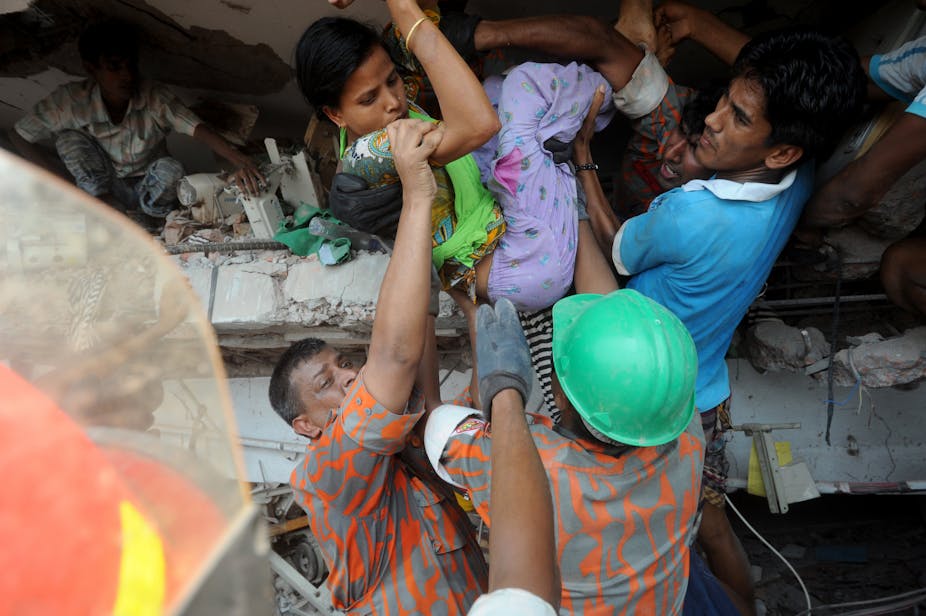In the five years since the collapse of the Rana Plaza garment factory building in Bangladesh – in which more than 1,134 people lost their lives and hundreds were injured – a variety of strategies have been developed to improve labour conditions and prevent another such disaster. The most prominent of these efforts are private programmes to inspect and upgrade factory buildings where government safety regulations have fallen short.
Much less attention has been paid to another approach to improving labour standards that could have a big impact in Bangladesh: workers’ compensation.
Workers’ compensation is the payment of cash benefits to injured workers or the families of those killed on the job. Though these payments are minimal – usually covering only lost wages and costs of medical care – workers’ compensation ensures that occupational injuries do not result in secondary health problems and destitution.
Underpinned by a system of employment injury insurance (EII), these compensation payments are guaranteed and automatic rather than fought for in the courts. The modern system of workers’ compensation was first established in Otto von Bismarck’s Germany in the 1880s, which entitled injured workers to limited benefits and employers to protection from liability in what is seen as a basic bargain between capital and labour.
Read more: Five years after deadly factory fire, Bangladesh's garment workers are still vulnerable
At the time of Rana Plaza’s collapse, compensation law for Bangladeshi workers was weak and widely unenforced. In response, the International Labour Organization (ILO) spearheaded a singular effort to pay compensation to the injured workers and families of those killed. The Rana Plaza Arrangement was a collaborative, voluntary agreement between global apparel companies, trade unions, the Bangladesh government, local employers and labour rights NGOs to make certain that those affected by Rana Plaza would receive at least the minimum standards of compensation specified in the ILO’s Employment Injury Benefits Convention No. 121. The Rana Plaza Arrangement completed payments to affected workers and families in 2015.

Funded mostly by companies that source goods from Bangladesh, the Rana Plaza Arrangement ensured that injured workers and bereaved families received the minimum social protection that is widely accepted as a basic labour right.
Today, the Bangladesh labour movement and its supporters are pushing for the adoption of a national employment injury insurance system to guarantee workers’ compensation that is automatic, fair and meets international standards. It can be difficult to advocate for employment injury insurance because it conjures up images of occupational injuries and deaths that everyone wants to see prevented. But, as the Solidarity Center reported in March 2018, at least 477 workers have been injured and 47 killed in Bangladesh’s garment factories since Rana Plaza.
As Bangladeshi labour activist Kalpona Akter recently said in a statement from the Clean Clothes Campaign: “All these disasters we have seen, with difficult compensation process and only limited options for compensation in Bangladesh labour law, show how much we need a national employment injury insurance scheme.” She called on the Bangladeshi government to pass and enact legislation as soon as possible.
Moving towards state solutions
As my research on the Rana Plaza Arrangement shows, workers compensation is a basic, sometimes meagre form of compensation. Because it is a mechanism to deliver automatic benefits for occupational injuries and fatalities, it leaves out matters of liability and negligence, excludes from compensation the “pain and suffering” of bereaved families or disabled workers, and does not award punitive damages.
In the face of a rapacious global industry that routinely underpays Bangladeshi workers – even after a recent increase in the minimum wage which represents only half what is considered a living wage in the country – the gains to be made with national employment injury insurance can seem small. But an automatic mechanism to disburse basic benefits after an industrial incident can mean the difference between a vulnerable family getting by or falling into destitution.
An additional benefit of national employment injury insurance is that it obliges the government to take responsibility for social protection. Critics of top-down safety initiatives such as the Accord on Fire and Building Safety in Bangladesh (signed between global trade union federations and multinational apparel companies in 2013) argue that they erode state institutions and trample on sovereignty by marginalising the Bangladesh government and local employers. In contrast, a national employment insurance system will require the robust engagement of state institutions and factory owners.
As a Bangladeshi labour leader I interviewed in 2016 put it, making such a scheme permanent requires changes to labour law that will specify the obligations of government and employers: “We need to update the labour law to reflect the need for compensation for injured workers. Not just a short-term project from international organisations. It needs to be changed in [Bangladesh] law.”
Bangladeshi garment workers need a greater voice and legal support for the formation of trade unions and collective bargaining. The ILO has been advocating for these labour rights even as it now focuses efforts to bring about employment injury insurance. If the Bangladesh government and local employers can make employment injury insurance a reality, it will be a positive sign that the environment for workers in Bangladesh is improving. We should demand that global brands and retailers support these efforts too.

